Traveling in Hanoi offers numerous beautiful and enticing destinations for tourists. Among them, Ngoc Son Temple is always a top choice for visitors. In the following article, DanangPrivateCar.com’s shares with everyone the travel experience to Ngoc Son Temple that tourists should not miss.
Table of Contents
Introduction to Ngoc Son Temple
Location: Ngoc Island, Hoan Kiem Lake, Dinh Tien Hoang Street, Hang Trong Ward, Hoan Kiem District, Hanoi
Ticket prices for reference:
- Adults: 30,000 VND/person
- Children under 15 years old: Free admission
Ngoc Son Temple is located on Ngoc Island, in the northeast of Hoan Kiem Lake. This structure, combined with the Turtle Tower, forms the most famous cultural and historical complex in Hanoi, featured in many literary works and artworks. Despite being situated in the bustling capital, attracting many visitors, Ngoc Son Temple maintains its tranquility, solemnity, and profoundly sacred atmosphere.
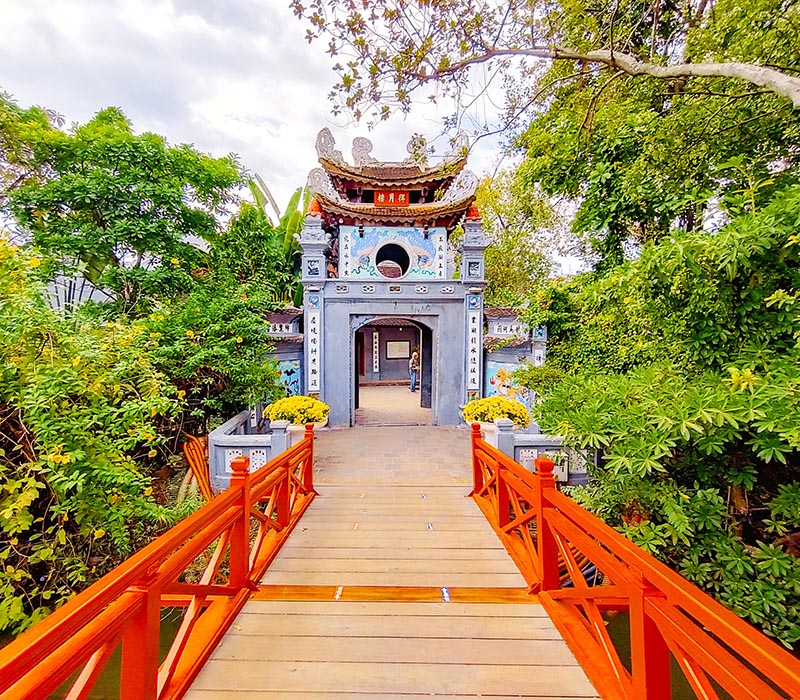
When to visit Ngoc Son Temple?
Ngoc Son Temple is a spiritual tourism destination, so tourists can visit and make offerings at the temple. For tourism to Ngoc Son Temple in Hanoi, tourists should visit at the beginning of the year to pray for luck, health, and success. Tourists can visit Ngoc Son Temple at any time of the year to explore and admire the scenery at the temple.
The Construction History of Ngoc Son Temple
Ngoc Son Temple was built to worship Hung Dao Dai Vuong Tran Quoc Tuan and the patron saint of literary and scholarly accomplishments, Van Xuong De Quan. Additionally, Buddhist altars and Confucian shrines were also placed within the temple. This structure was built in an architectural style that clearly reflects the ancient Vietnamese belief in the unity of Three Religions (Tam Giao Dong Nguyen), representing the convergence of Buddhism, Taoism, and Confucianism. Familiar imagery such as couplets, horizontal lacquered boards, and decorative arrangements all vividly demonstrate this.

Ngoc Son Temple was originally constructed around the early 19th century to worship Quan De, a deity believed to suppress evil and bring blessings according to the beliefs of the people at that time. When King Ly Thai To relocated the capital to Thang Long, he named this temple Ngoc Tuong. Later, during the Tran dynasty, the temple was renamed Ngoc Son. At this time, the temple became a place of worship for the valiant martyrs who fought and sacrificed in the resistance against the Yuan-Mongol invaders. Some time later, the temple collapsed due to an unstable foundation.
During the reign of King Vinh Huu of the Le dynasty, Lord Trinh Giang ordered the construction of Khanh Thuy Palace and added two earth mounds on the eastern shore of Hoan Kiem Lake, opposite the original location of Ngoc Son Temple. By the end of the Le dynasty, Khanh Thuy Palace was partially destroyed, so the people of Ta Khanh village collectively rebuilt it, naming it Khanh Thuy Temple.
In the following period, a philanthropist named Tin Trai invested in building Ngoc Son Pagoda at the old location of Khanh Thuy Palace. Later, the pagoda was transferred to another philanthropic association, renamed Tam Thanh Temple. The association decided to abandon the bell tower, rebuild the main halls, rooms, and install a statue of Van Xuong De Quan, officially renaming it Ngoc Son Temple.
In 1865, Confucian scholar Nguyen Van Sieu renovated Ngoc Son Temple, added surrounding land, built sturdy stone embankments, erected the Pen Tower, the Ink Slab, built the Trấn Ba Pavilion to the south, and the The Huc Bridge connecting the eastern shore to the temple.
Guide to Getting to Ngoc Son Temple
Because Ngoc Son Temple is located in the city center, getting there is quite easy, and you can travel by either self-driving or public transportation.
If you’re traveling by private vehicle, you can choose one of the following routes:
- Route 1: Kham Thien → Tran Hung Dao → Hang Bai → Dinh Tien Hoang
- Route 2: Giang Vo → Nguyen Thai Hoc → Hai Ba Trung → Dinh Tien Hoang
- Route 3: Dai Co Viet → Hue Street → Dinh Tien Hoang
If you prefer the convenience of traveling by bus, you can choose from the routes suggested by DanangPrivateCar.com:
- Route 08: Departing from Long Bien bus station
- Route 14: Departing from Co Nhue
- Route 31: Departing from Bach Khoa University
- Route 36: Departing from Long Bien transfer point
Furthermore, if you’re looking for door-to-door transportation and want to explore multiple tourist destinations, choosing a tour car rental service with a driver in Hanoi from DanangPrivateCar.com’s will help you save costs and time during your trip. With a team of professional drivers and many years of experience, you’ll have the safest and most comfortable journey. Additionally, with transparent pricing and no hidden fees, you can avoid overcharging situations when choosing public services in Vietnam. Book with us today to arrange your itinerary in advance.
Explore the Beauty of Ngoc Son Temple
The Huc Bridge
The Huc Bridge, painted in vermilion, curved like a shrimp, leads to Ngoc Son Temple, as familiar as the sentences we learn in textbooks. This bridge is built of wood, prominently painted in red. It is the only way for you to enter Ngoc Son Temple and is also a very famous check-in spot in Hanoi. Especially at night when lit up, the beauty of The Huc Bridge becomes even more mystical.
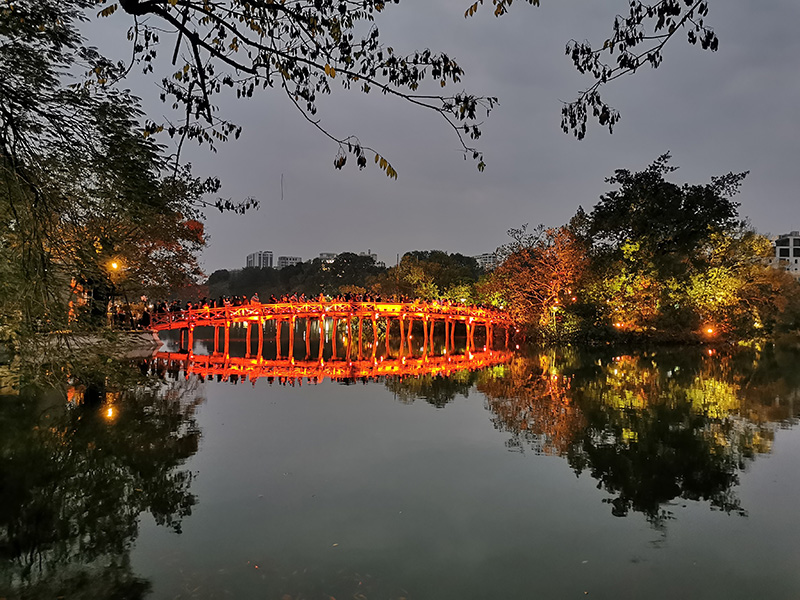
Visit the Pen Tower – Ink Slab
Right in front of Ngoc Son Temple’s entrance, you will see the image of a five-story tower built of stone blocks, and that is the Pen Tower. This structure was built in 1865, located on Ngoc Boi Mountain. On the top of the Pen Tower are inscribed three characters “Ta Thanh Thien,” meaning “Writing on the blue sky,” expressing the significance of knowledge being able to master nature and the heavens.
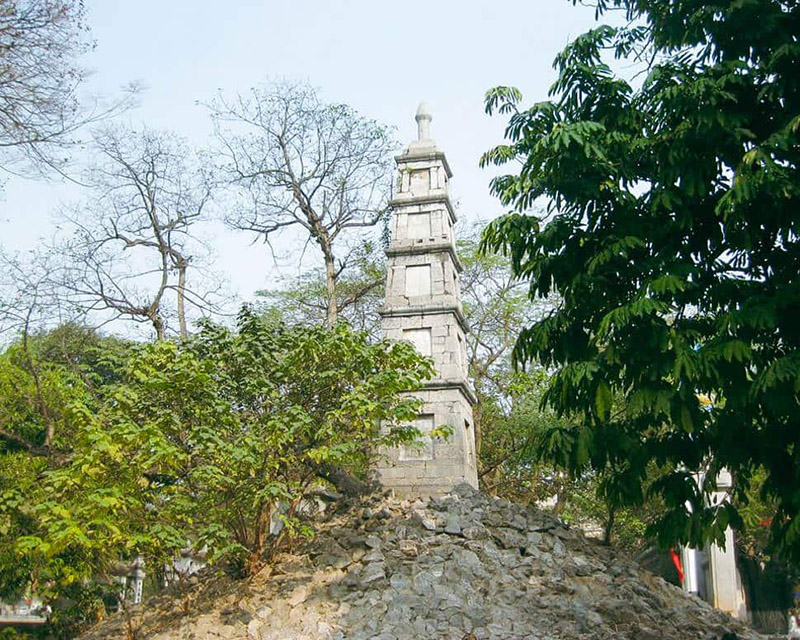
At the foot of the Pen Tower is an inkwell-shaped ink slab cut in half vertically, this is the Ink Slab. Below the Ink Slab are three turtle-shaped pedestals, with a poem carved on the body by Confucian scholar Nguyen Van Sieu. At noon, when the sun is directly overhead, the Pen Tower will cast a shadow onto the Ink Slab, creating a very impressive image.
Discover the Architecture of Ngoc Son Temple
Despite undergoing several renovations, the architecture of Ngoc Son Temple still retains its characteristic traditional beauty. As you walk from the outer gate, you will see a wall decorated with images of dragons and tigers, with two couplets in Chinese characters above, demonstrating the Vietnamese people’s thirst for knowledge.
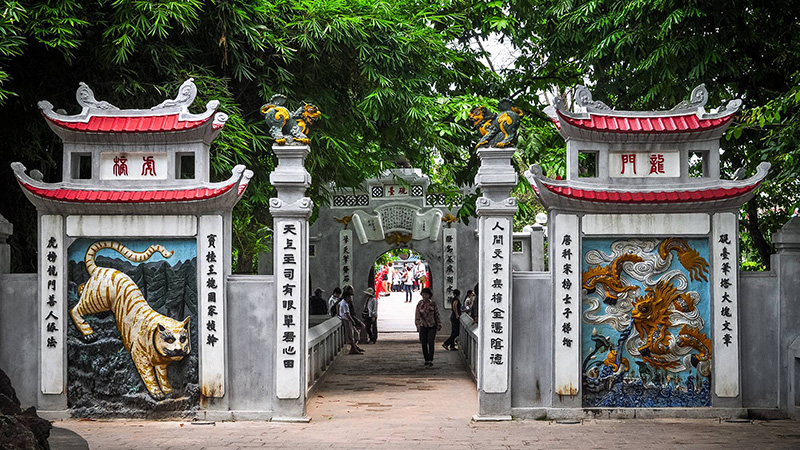
After crossing The Huc Bridge, the first structure you’ll see is the Moon Contemplation Pavilion. The design of the Moon Contemplation Pavilion consists of two arched roofs, adorned with cloud-shaped reliefs at the four corners. Here, there are also two embossed murals: Long Ma Ha Do on the right and Than Qui Lac Thu on the left.
The architecture of Ngoc Son Temple is in the shape of the word “Tam” (Three), consisting of three main areas: the front courtyard, the middle courtyard, and the rear palace. The front courtyard is where people come to worship, with a large incense burner and two large brass cranes erected. The middle courtyard is dedicated to the worship of gods representing knowledge such as Van Xuong, Quan Vu, and La To. The rear palace is where the national hero Tran Hung Dao, who had great merit to the nation, is honored for defeating the Mongol invaders three times.
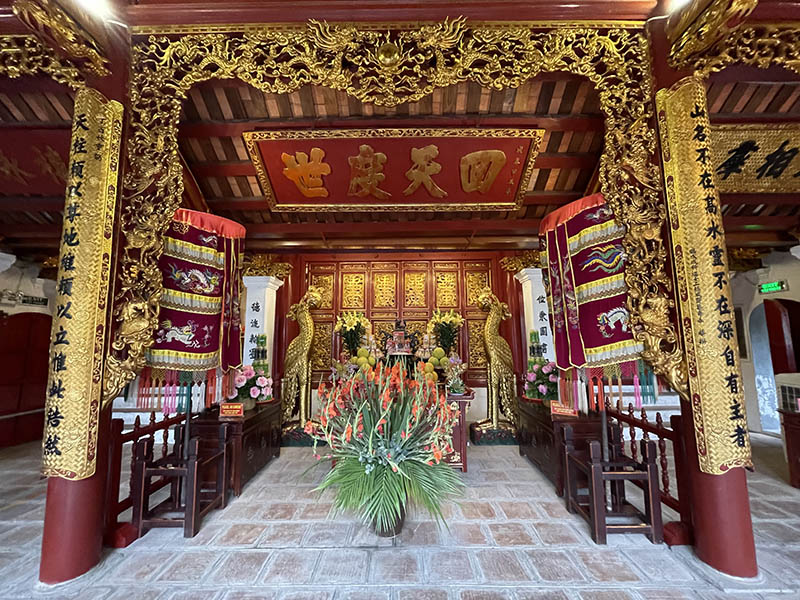
To the south of the Ngoc Son Temple compound, there is a small shrine called Tran Ba (wave-blocking shrine). This shrine is built with a square architecture, eight roofs, and eight support columns. Four outer columns are made of stone and four inner columns are made of wood.
Inside Ngoc Son Temple are also displayed two replicas of the sacred turtle enclosed in glass cases. On the left is a replica of the turtle found deceased in 1967, and on the right is a replica of the turtle found in 2016. The legendary stories of the sacred turtles at Hoan Kiem Lake have fascinated many people when they have the opportunity to witness them with their own eyes.

Notes when visiting Ngoc Son Temple
- You can visit Ngoc Son Temple any day of the year. However, it can be quite crowded on the first and fifteenth days of the lunar month, so it’s better to choose a regular day when it’s less crowded.
- When entering the main temple, please note to enter through the side doors and avoid the central door.
- During the temple visit, tourists should ensure to maintain order, dress modestly, and maintain a solemn attitude.
- Limit taking photos inside the worship area.
Ngoc Son Temple is a tourist destination that surely no one can overlook when visiting the capital city of Hanoi. Hopefully, with the shared experiences about visiting Ngoc Son Temple here, it will help travelers have a wonderful trip and gain more valuable knowledge about Vietnamese temples.

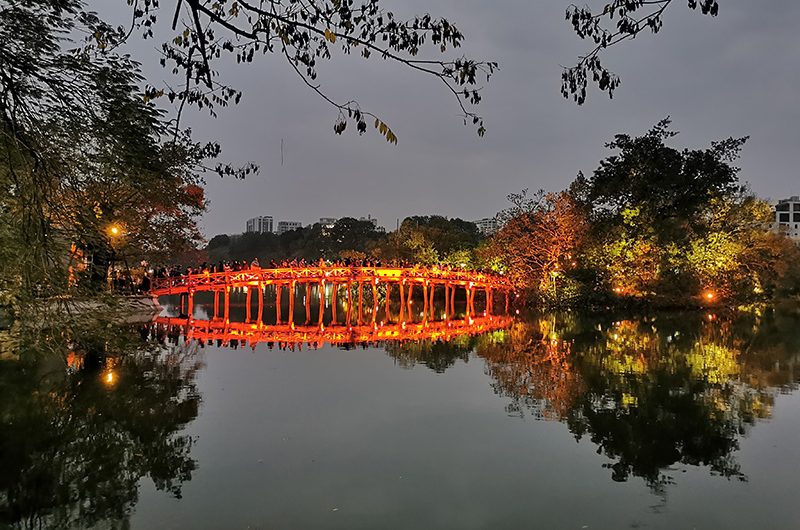
Comments